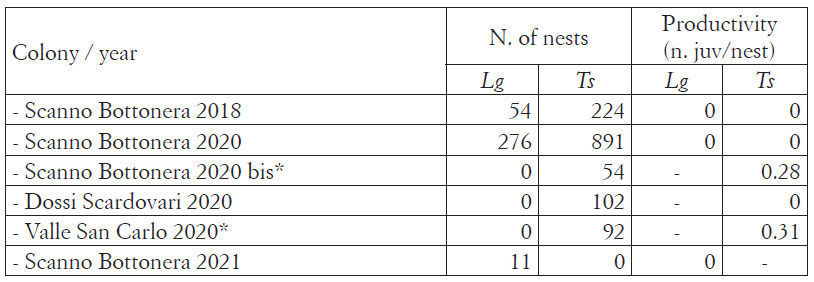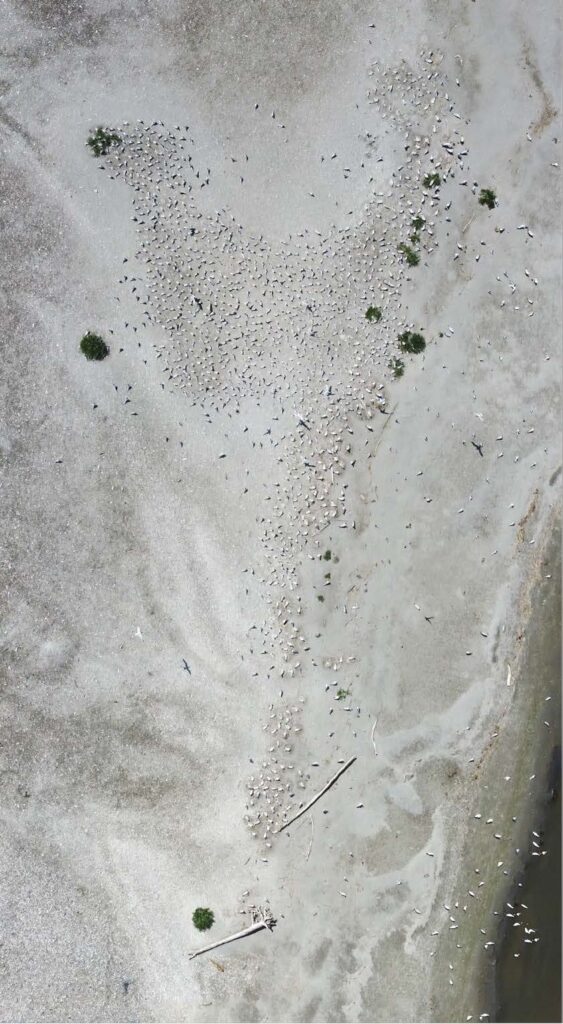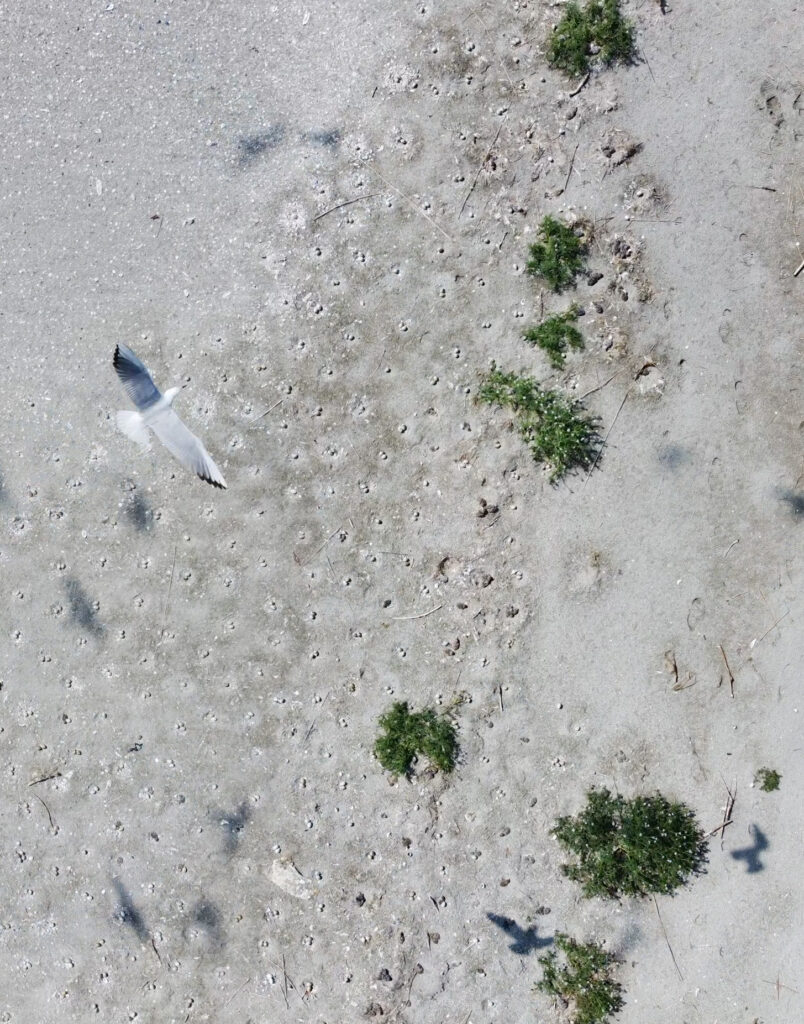Notabreve
Recente insediamento di Gabbiano roseo e Beccapesci nel Delta del Po veneto (anni 2018-2021)
Introduzione
We report the results of monitoring two species of Laridae, Slender-billed Gull (Larus genei) and Sandwich Tern (Thalasseus sandvicensis), collected during their colonization of the northern Po Delta (Province of Rovigo, NE Italy), in the years 2018-2021. Counts were conducted through both traditional ground surveys and drone flights (Valle & Scarton, 2018).
Both species nested in three years out of four in the period 2018-2021 (Tab. 1), with relevant populations. In the past, only sporadic attempts were noticed in the last decade, occurring only in fish-farms. Slender-billed Gulls nested in Valle Scanarello (three pairs) in 2015 (Piccolo & Sturaro in Sighele et al., 2017), whereas Sandwich Terns nested only in 2014, when a small colony, less than 20 pairs, settled in Valle San Carlo fish-farm, fledging several young (pers. obs.).

Both species selected for nesting areas with very low vegetation cover, both on natural barrier islands (Fig. 1) and artificial mounds, usually building nests in the highest available areas above the tideline. Colonies hosted both species only in two cases out of six, but the respective nests were scattered in different areas of the colony, only marginally overlapping as demonstrated by drone imagery (Figs. 1-2). Other species nesting in the surroundings (100-m radius) were: Eurasian Oystercatchers (Haematopus ostralegus): 67% of the colonies, Pied Avocets (Recurvirostra avosetta): 50%, Kentish Plovers (Charadrius alexandrinus): 50%, Mediterranean Gulls (Larus melanocephalus): 17%, Yellow-legged Gulls (Larus michahellis): 17%, Little Terns (Sternula albifrons): 67%, Common Terns (Sterna hirundo): 67%.
Overall productivity was very low (Tab. 1), mostly due to flooding by exceptionally high tides, whereas to lesser extent it was possibly due to predation by Yellow-legged Gulls.


Both species were found for the first time as breeding birds in the northern Po Delta (Scarton et al., 2018; Valle & Verza, 2020) except for the few negligible cases above mentioned. This finding becomes even more relevant if one considers that in Italy, both species are restricted to a few sites.
The Slender-billed Gull is found in Emilia-Romagna, Sardinia, Sicily and Apulia with 3000-5000 pairs, for the years 2006-2012. The same estimate is also reported for the period 2007-2018 (Ercole et al., 2021). Its status is favourable, with an incremental trend, albeit the distribution area has doubled recently, reasonably as a result of fragmentation of the core colonies, at least partly due to deterioration of the breeding sites (Nardelli et al., 2015).
The distribution of the Sandwich Tern is even more localised, being restricted to a few coastal sites in Emilia-Romagna and Veneto, with the exception of the irregular and numerically negligible nesting in the Margherita di Savoia saltpans in Apulia. The population trend is positive in the long term, but uncertain in the short term and 798-821 pairs were estimated for the whole Italy for 2008-2012 by Nardelli et al., 2015. National estimates published so far (Ercole et al., 2021) report the same range of pairs, a value that is actually lower than that of the Venice lagoon alone, where a maximum of 1878 pairs was reached in 2017, with an average of about 1600 pairs in the period 2016-2018 (Scarton & Valle, 2021). In that three-year period, taking into account the 224 breeding pairs in the Po delta, the Veneto alone therefore had a population of around 1,700 pairs on average. The settlement in the northern Po Delta, object of this note, is reasonably due to adults coming from the Venice Lagoon, where the population has recently shown a numerical decrease (Scarton & Valle, 2021) after the peak
recorded in previous years (Scarton & Valle, 2017). The large discrepancies between the various estimates published to date for the entire Italian population highlight the need for a nationally coordinated census.
The colonization of the northern Po Delta by both the studied species are of great interest, also in view of the need for adequate breeding sites for both of them, given the small size of the populations, which are concentrated in few breeding sites, and the deterioration of some of the latter (Nardelli et al., 2015). Unfortunately, productivity in our study area was seriously unsatisfactory for both the studied species, due to the factors already mentioned. Hence the need for a careful search for new nesting sites in order to monitor the productivity of both species and implement the appropriate and necessary conservation measures, which so far have never been enforced.
References
Ercole S., Angelini P., Carnevali L., Casella L., Giacanelli V., Grignetti A., La Mesa G., Nardelli R., Serra L., Stoch F., Tunesi L., Genovesi P. (ed.), 2021. Rapporti Direttive Natura (2013-2018). Sintesi dello stato di conservazione delle specie e degli habitat di interesse comunitario e delle azioni di contrasto alle specie esotiche di rilevanza unionale in Italia. ISPRA, Serie Rapporti, 349/2021.
Nardelli R., Andreotti A., Bianchi E., Brambilla M., Brecciaroli B., Celada C., Duprè E., Gustin M., Longoni V., Pirrello S., Spina F., Volponi S., Serra L. (2015) – Rapporto sull’applicazione della Direttiva 147/2009/CE in Italia: dimensione, distribuzione e trend delle popolazioni di uccelli (2008-2012). ISPRA, Serie Rapporti, 219/2015.
Scarton F., Valle R.G. (2017) – Andamento recente (2013-2015) delle popolazioni di uccelli acquatici nidificanti nella laguna aperta di Venezia. Bollettino del Museo di Storia Naturale di Venezia, 67: 113-123.
Scarton F., Valle R.G. (2021) – Uccelli acquatici nidificanti nella laguna aperta di Venezia: stime di popolazione per gli anni 2016-2018 e andamenti di medio periodo. Lavori della Società Veneziana di Scienze Naturali, 46: 5-16.
Scarton F., Verza E., Guzzon C., Utmar P., Sgorlon G., Valle R. (2018) – Laro-limicoli (Charadriiformes) nidificanti nel litorale nord adriatico (Veneto e Friuli-Venezia Giulia) nel periodo 2008-2014: consistenza, trend e problematiche di conservazione. RIO – Research in Ornithology, 88: 33-41.
Sighele M., Bon M., Verza E. – Associazione Faunisti Veneti (2017) – Rapporto ornitologico per la regione Veneto. Anno 2015. Bollettino del Museo di Storia Naturale di Venezia, 67: 77-112.
Valle R.G., Scarton F. (2018) – Uso dei droni nel censimento degli uccelli acquatici nidificanti nel nord adriatico. Bollettino del Museo Storia Naturale di Venezia, 69: 69-75.
Valle R.G., Verza E. (2020) – I laro-limicoli (Charadriiformes) nidificanti nel Delta del Po Veneto (RO) nel periodo 2015-2018. Bollettino del Museo di Storia Naturale di Venezia, 71: 123-126.
Acknowledgments
We would like to thank Niki Penini and Giuliano Zanellato for their help in the field.


